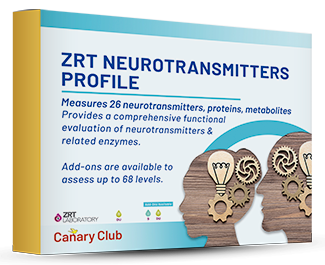Mild to moderate depression affects up to 10% of the U.S. population.
Depression is the third most reported chronic health condition in the U.S.
Most family practice providers, internists, and specialists will see some degree of mood disorders in their practices. Virtually all clinical reports on mood disorders identify neurotransmitter imbalances as contributors to either the root cause or the symptoms of depression and anxiety.
Addressing neurotransmitter imbalances is a highly effective approach for successful clinical outcomes in terms of targeted treatment, cost, and compliance.

Clinical symptoms of mood disorders can be grouped into three basic categories:
- Emotional: Depressed mood, lack of motivation, disinterest in social activity, anxiety
- Cognitive: Inability to concentrate, poor memory
- Physical: Insomnia, headache, fatigue, and pain
Neurotransmitter imbalances are associated with all of these groups, and many individuals experience a combination of symptoms that may span all three categories!
Exploration of the underlying biochemistry of these symptoms often leads to the identification of imbalances in two key neurotransmitters -- serotonin and norepinephrine. A disruption in the balance of either, or both, of these neurotransmitters, represents a common neurochemical shift that results in mood changes.
 Serotonin imbalances are associated with:
Serotonin imbalances are associated with:
-
-
-
-
- Poor impulse control
- Low sex drive
- Decreased appetite
- Irritability
-
-
-
Norepinephrine imbalances are associated with:
-
-
-
-
- Poor attention and memory
- Decreased concentration
- Reduced socialization
- Altered states of arousal
-
-
-
Although serotonin and norepinephrine imbalances are often the primary culprits responsible for mood disturbances, dopamine, GABA, glutamate, estrogen, progesterone, cortisol, and testosterone imbalances can all play a significant causative or contributory role in mood disorders. Addressing each of these neurotransmitters and hormones simultaneously is the most efficient route to wellness.
Dopamine is responsible for regulating the pleasure/reward pathway, memory, and motor control. Many stimulants cause dopamine to be released into the neuronal synapse, which can lead to a reduction in demand for dopamine and contribute to depleted levels over time.
GABA also plays a significant role in maintaining mood because it is essential in balancing the excitatory effects of norepinephrine, epinephrine, and dopamine. Neuroexcitatory overload can raise the demand for GABA. Low GABA levels also contribute to mood disorders and may be associated with anxiety, worry, and poor impulse control.
Glutamate is a major excitatory neurotransmitter in the CNS and is involved in most aspects of brain function including cognition, memory, and learning. Due to its excitatory role, high levels of glutamate are often associated with panic attacks, anxiety, and depression.
Sex hormones play a role in mood disorders as well. Estrogen increases serotonin receptor sensitivity, increases serotonin production, and serves as a dopamine modulator. Progesterone is a GABA agonist and has a significant effect on the body's HPA axis to manage stress and maintain a balanced mood. Fluctuations in both estrogen and progesterone, as seen in women of all ages, correlate to fluctuations in these mood-regulating neurotransmitters.
Testing both neurotransmitters and hormones provides a comprehensive and foundational view of the body's functional neuroendocrine status, and brings to light multiple factors that contribute to symptoms, allowing for defined, targeted treatments and improved clinical outcomes.
ZRT Neurotransmitters Profile
 See our ZRT Neurotransmitters Profile to check your neurotransmitter levels. Samples are taken from dried urine, with the exception of the saliva steroids add-on option.
See our ZRT Neurotransmitters Profile to check your neurotransmitter levels. Samples are taken from dried urine, with the exception of the saliva steroids add-on option.
Neurotransmitters Test Kit Includes:
Neurotransmitters Dried Urine: GABA, Glu, Gly, DA, Epi, NE, HIST, 5-HT, PEA, DOPAC, HVA, 5-HIAA, NMN, VMA, Trp, Kyn, 3-OHKyn, Tau, Gln, His, N-MeHist, Tyra, KynAc, Xanth, Tyr, Crtn
Available Neurotransmitter Add-ons:
You will be able to include these add-ons during the ordering process for the Neurotransmitters Panel.
Neurotransmitters + Saliva Steroids Concerned about hormone imbalances? Use the tube in the Neurotransmitter kit to collect a Saliva sample for Estradiol, Progesterone, Testosterone, DHEA-S & AM Cortisol.
Neurotransmitters + Diurnal Cortisol (UDH) I Don't want to test Melatonin. Add only Free Cortisol & Free Cortisone x4 to the same samples being collected for Neurotransmitters.
Neurotransmitters + Diurnal Cortisol & Melatonin UDH II - For concerns about adrenal or sleep issues, add 4-point Cortisol, Cortisone & Melatonin to the same samples being collected for Neurotransmitters.
Neurotransmitters + Diurnal Cortisol, Melatonin, Norepinephrine & Epinephrine UDH III For concerns about adrenal or sleep, stress issues, add Free Cortisol x 4, Free Cortisone x 4, Melatonin (MT6s) x 4, NE x 4 & Epi x 4 to the same samples being collected for Neurotransmitters.
add 7 Toxic Heavy Metals Urine Elements – $99 – Add tests for Iodine, Bromine, Selenium, Lithium, Arsenic, Cadmium & Mercury
Additional Resources
- Neurotransmitter Fact Sheet
- Neuroendocrine Imbalances and Depression
- Our Emotions Reflect Our Neurotransmitter Hormone Balance
- Why You Might Be Starving Your Brain
- Dopamine and New Year's Resolutions
- Neurotransmitter Disruption and Adrenal Function
- Neurotransmitter Imbalances and Mood Disorders
- Forbes Article
References:
- http://www.cdc.gov/Features/dsDepression
- http://www.gallup.com/poll/145868/chronic-health-conditions-prevalent-2010-2009.aspx
- Akiskal HS. Mood disorders: introduction and overview. In: Kaplan HI, Sadock BJ, eds. Comprehensive Textbook of Psychiatry. 6th ed. Baltimore, Md: Lippincott, Williams & Wilkins; 1995:1067-1079.
- Grossman F, Potter WZ. Catecholamines in depression: a cumulative study of urinary norepinephrine and its major metabolites in unipolar and bipolar depressed patients versus healthy volunteers at the NIMH. Psychiatry Res. 1999 Jul 30;87(1):21-7.
- Gonzales GF, Carillo C. Blood serotonin levels in postmenopausal women: effects of age and serum oestradiol levels. Maturitas. 1993;17:23-9.
- Kaura V, et al. The progesterone metabolite allopregnanolone potentiates GABAa receptor-mediated inhibition of 5-ht neuronal activity. Eur Neuropsychopharm. 2007; 17: 108-15.

